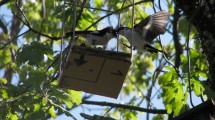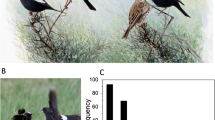Abstract
The Australian sleepy lizard, Tiliqua rugosa, maintains monogamous associations for an average of 6 weeks before mating each spring. One hypothesis to explain this prolonged partnership is that males are guarding their female partners from rival males. This hypothesis has three predictions, that males are more aggressive than females to conspecific males, that male aggression will increase as the time of mating gets closer, and that males will be more aggressive towards conspecific males when they are with their partner than when they are alone. We tested those predictions with indirect evidence of aggression, using counts of scale damage on randomly encountered lizards, and with direct observations of their responses to approaches by conspecific and heterospecific models. As predicted by the mate guarding hypothesis, males showed more evidence of aggression towards conspecifics than did females. However, in contrast to the hypothesis, males did not become more aggressive as the time of mating came closer, and males in pairs were less aggressive than males on their own. Mate guarding cannot be the only process that has led to the prolonged monogamous associations in this species. Parental care is also unknown in these lizards, and we suggest that monogamy may be maintained through some form of female coercion, allowing females to gain additional fitness from the enhanced vigilance that results from male proximity.
Similar content being viewed by others
References
Benson DP (2002) Low extra-pair paternity in the white-tailed ptarmigan. Condor 104:192–197
Black JM (1996) Introduction: pair bonds and partnerships. In: Black JM (ed) Partnerships in birds: the study of monogamy. Oxford University, Oxford, pp 3–20
Blomqvist D, Kempenaers B, Lanctot RB, Sandercock BK (2002) Genetic parentage and mate guarding in the arctic breeding western sandpiper. Auk 119:228–233
Brotherton PNM, Manser MB (1997) Female dispersion and the evolution of monogamy in the dik-dik. Anim Behav 54:1413–1424
Bull CM (1988) Mate fidelity in an Australian lizard Trachydosaurus rugosus. Behav Ecol Sociobiol 23:45–49
Bull CM (1990) Comparisons of displaced and retained partners in a monogamous lizard. Aust Wildl Res 17:135–140
Bull CM (1994) Population dynamics and pair fidelity in sleepy lizards. In: Vitt LJ, Pianka ER (eds) Lizard ecology: historical and experimental perspectives. Princeton University, Princeton, pp 159–174
Bull CM (1995) Population ecology of the sleepy lizard, Tiliqua rugosa, at Mt. Mary, South Australia. Aust J Ecol 20:393–402
Bull CM (2000) Monogamy in lizards. Behav Process 51:7–20
Bull CM, Baghurst BC (1998) Home range overlap between mothers and their offspring in the sleepy lizard, Tiliqua rugosa. Behav Ecol Sociobiol 42:357–362
Bull CM, Burzacott D (2001) Temporal and spatial dynamics of a parapatric boundary between two Australian reptile ticks. Mol Ecol 10:639–648
Bull CM, Burzacott D (2002) Changes in climate and in the time of pairing of the Australian lizard, Tiliqua rugosa: a 15 year study. J Zool 256:383–387
Bull CM, Lindle C (2002) Following trails of partners in the monogamous lizard, Tiliqua rugosa. Acta Ethol 5:25–28
Bull CM, Pamula Y (1996) Sexually dimorphic head sizes and reproductive success in the sleepy lizard Tiliqua rugosa. J Zool 240:511–521
Bull CM, Pamula Y (1998) Enhanced vigilance in monogamous pairs of the lizard, Tiliqua rugosa. Behav Ecol 9:452–455
Bull CM, McNally A, Dubas G (1991) Asynchronous seasonal activity in male and female sleepy lizards, Tiliqua rugosa. J Herpetol 25:436–441
Bull CM, Bedford GS, Schulz BA (1993a) How do sleepy lizards find each other? Herpetologica 49:294–300
Bull CM, Pamula Y, Schulze L (1993b) Parturition in the sleepy lizard Tiliqua rugosa. J Herpetol 27:489–492
Bull CM, Cooper SJB, Baghurst BC (1998) Social monogamy and extra-pair fertilization in an Australian lizard, Tiliqua rugosa. Behav Ecol Sociobiol 44:63–72
Carpenter CC, Murphy JB (1978) Tongue display by the common bluetongue (Tiliqua scincoides) (Reptilia, Lacertilia, Scincidae). J Herpetol 12:428–429
Catry P, Furness RW (1997) Territorial intrusions and copulation behaviour in the great skua, Catharacta skua. Anim Behav 54:1265–1272
Censky EJ (1995) Mating strategy and reproductive success in the teiid lizard, Ameiva plei. Behaviour 132:529–557
Censky EJ (1997) Female mate choice in the non-territorial lizard Ameiva plei (Teiidae). Behav Ecol Sociobiol 40:221–225
Chuang-Dobbs HC, Webster MS, Holmes RT (2001) The effectiveness of mate guarding by male black-throated blue warblers. Behav Ecol 12:541–546
Cooper WE, Vitt LJ (1997) Maximizing male reproductive success in the broad-headed skink (Eumeces laticeps): preliminary evidence for mate guarding, size-assortative pairing, and opportunistic extra-pair mating. Amphibia–Reptilia 18:59–73
Creighton E (2000) Female mate guarding: no evidence in a socially monogamous species. Anim Behav 59:201–207
Cuadrado M (2001) Mate guarding and social mating system in male common chameleons (Chamaeleo chamaeleon). J Zool 255:425–435
Dawes-Gromadzki TZ (2002) Trophic trickles rather than cascades: conditional top-down and bottom-up dynamics in an Australian chenopod shrubland. Aust Ecol 27:490–508
Dickinson JL, Leonard ML (1996) Mate attendance and copulatory behaviour in western bluebirds: evidence of mate guarding. Anim Behav 52:981–992
Dickinson J, Haydock H, Koenig W, Stanback M, Pitelka F (1995) Genetic monogamy in single-male groups of acorn woodpeckers, Melanerpes formicovorus. Mol Ecol 4:765–769
Eens M, Pinxten R (1996) Female European starlings increase their copulation solicitation rate when faced with the risk of polygyny. Anim Behav 51:1141–1147
Freeland JR, Hannon SJ, Dobush G, Boag PT (1995) Extra-pair paternity in willow ptarmigan broods: measuring costs of polygyny to males. Behav Ecol Sociobiol 36:349–355
Gowaty PA (1996) Battles of the sexes and origins of monogamy. In: Black JM (ed) Partnerships in birds: the study of monogamy. Oxford University, Oxford, pp 21–52
Gubernick DJ, Nordby JC (1993) Mechanisms of sexual fidelity in the monogamous Californian mouse, Peromyscus californicus. Behav Ecol Sociobiol 32:211–219
How TL, Bull CM (2002) Reunion vigour: an experimental test of the mate guarding hypothesis in the monogamous sleepy lizard, Tiliqua rugosa. J Zool 257:333–338
John-Alder HB, Garland T, Bennett AF (1986) Locomotory capacities, oxygen consumption, and the cost of locomotion of the shingle-back lizard (Trachydosaurus rugosus). Physiol Zool 59:523–531
Kempenaers B, Verheyen GR, Dhondt AA (1995) Mate guarding and copulation behaviour in monogamous and polygynous blue tits: do males follow a best-of-a-bad-job strategy? Behav Ecol Sociobiol 36:33–42
Kerr G, Bull CM (2002) Field observations of aggressive encounters between male sleepy lizards Tiliqua rugosa. Herpetol Rev 33:24–26
Kerr GD, Bull CM, Burzacott D (2003) Refuge sites used by the scincid lizard Tiliqua rugosa. Aust Ecol 28:152–160
Krokene C, Anthonisen K, Lifjeld JT, Amundsen T (1996) Paternity and paternity assurance behaviour in the bluethroat, Luscinia s. svecica. Anim Behav 52:405–417
Leisler B, Wink M (2000) Frequencies of multiple paternity in three Acrocephalus species (Aves: Sylviidae) with different mating systems (A. palustris, A. arundinaceus, A. paludicola). Ethol Ecol Evol 12:237–249
Møller AP, Ninni P (1998) Sperm competition and sexual selection: a meta-analysis of paternity studies of birds. Behav Ecol Sociobiol 43:345–358
Møller AP, Tegelstrom H (1997) Extra-pair paternity and tail ornamentation in the barn swallow Hirundo rustica. Behav Ecol Sociobiol 41:353–360
Neill V, Lill A (1998) Mate guarding in the magpie lark. Corella 22:80–86
Olsson M (1993) Male preference for large females and assortative mating for body size in the sand lizard (Lacerta agilis). Behav Ecol Sociobiol 32:337–341
Olsson M, Shine R (1998) Chemosensory mate recognition may facilitate prolonged mate guarding by male snow skinks, Niveoscincus microlepidus. Behav Ecol Sociobiol 43:359–363
Olsson M, Gullberg A, Tegelstrom H (1996) Malformed offspring, sibling matings, and selection against inbreeding in the sand lizard (Lacerta agilis). J Evol Biol 9:229–242
Palombit RA (1996) Pair bonds in monogamous apes: a comparison of the siamang Hylobates syndactylus and the white-handed gibbon Hylobates lar. Behaviour 133:321–356
Parker GA (1974) Courtship persistence and female guarding as male time investment strategies. Behaviour 48:157–184
Pierce EP, Lifjeld JT (1998) High paternity without paternity-assurance behavior in the purple sandpiper, a species with high paternal investment. Auk 115:602–612
Pinxten R, Eens M (1997) Copulation and mate guarding patterns in polygynous European starlings. Anim Behav 54:45–58
Reavis RH (1997) The natural history of a monogamous coral-reef fish Valenciennea strigata (Gobiidae). 2. Behavior, mate fidelity and reproductive success. Environ Biol Fish 49:247–257
Reavis RH, Barlow GW (1998) Why is the coral reef fish Valenciennea strigata (Gobiidae) monogamous? Behav Ecol Sociobiol 43:229–237
Roberts SC, Dunbar RIM (2000) Female territoriality and the function of scent marking in a monogamous antelope (Oreotragus oreotragus). Behav Ecol Sociobiol 47:417–423
Robertson BC, Degnan SM, Kikkawa J, Moritz CC (2001) Genetic monogamy in the absence of paternity guards: the Capricorn silvereye, Zosterops lateralis chlorocephalus, on Heron Island. Behav Ecol 12:666–673
Saino N, Primmer CR, Ellegren H, Møller AP (1999) Breeding synchrony and paternity in the barb swallow (Hirundo rustica). Behav Ecol Sociobiol 45:211–218
Schleicher B, Hoi H, Valera F, Hoi LM (1997) The importance of different paternity guards in the polygynandrous penduline tit (Remiz pendulinus). Behaviour 134:941–959
Somma LA (1990) A categorization and bibliographic survey of parental behavior in lepidosauran reptiles. Smithson Herpetol Inf Serv 81:1–53
Soukup SS, Thompson CF (1997) Social mating system affects the frequency of extra-pair paternity in house wrens. Anim Behav 54:1089–1105
Stamps JA (1983) Sexual selection, sexual dimorphism, and territoriality. In: Huey RB, Pianka ER, Schoener TW (eds) Lizard ecology. Studies of a model organism. Harvard University, Cambridge, pp 169–204
Takegaki T (2000) Monogamous mating system and spawning cycle in the gobiid fish, Amblygobius phalaena (Gobiidae). Environ Biol Fish 59:61–67
Wagner RH, Schug MD, Morton ES (1996) Condition-dependent control of paternity by female purple martins: implication for coloniality. Behav Ecol Sociobiol 38:379–389
Wallander J, Blomqvist D, Lifjeld JT (2001) Genetic and social monogamy: does it occur without mate guarding in the ringed plover? Ethology 107:561–572
Wickler W, Seibt U (1983) Monogamy: an ambiguous concept. In: Bateson P (ed) Mate choice. Cambridge University, Cambridge, pp 33–50
Acknowledgements
This research was supported by funds from the Australian Research Council and the School of Biological Sciences, Flinders University. We thank Lorraine Baker for field assistance, Dale Burzacott for technical help, and Ron and Leona Clarke for accommodation at Bundey Bore. The study was conducted according to the guidelines of the Flinders University of South Australia Animal Welfare Committee in compliance with the Australian Code of Practice for the use of animals for scientific purposes.
Author information
Authors and Affiliations
Corresponding author
Additional information
Communicated by R. Serrão Santos
Rights and permissions
About this article
Cite this article
Murray, K., Bull, C.M. Aggressiveness during monogamous pairing in the sleepy lizard, Tiliqua rugosa: a test of the mate guarding hypothesis. acta ethol 7, 19–27 (2004). https://doi.org/10.1007/s10211-004-0092-2
Received:
Revised:
Accepted:
Published:
Issue Date:
DOI: https://doi.org/10.1007/s10211-004-0092-2




